
TypeScript: From JavaScript Superset to Go-Powered Powerhouse
Discover how TypeScript evolved from a JavaScript superset to a blazing-fast, Go-powered compiler shaping modern web development.
In March 2025, Microsoft shook the developer world: the TypeScript compiler was being rewritten in Go, promising up to 10× faster builds. For a language born as a JavaScript superset, this shift to a lower-level language marked a pivotal evolution—not just in performance, but in purpose.
But to understand the why, we need to rewind.
The JavaScript Pain Point
In the early 2010s, JavaScript was everywhere—but cracks were showing:
- Runtime errors only surfaced during execution
- Refactoring was risky
- Large apps were fragile
- Small mistakes had big consequences
Companies like Slack faced growing pains maintaining massive JavaScript codebases. JavaScript’s dynamic nature, once a strength, had become a liability.
TypeScript’s Bet: Structure Without Sacrifice
Enter TypeScript, a side project at Microsoft led by Anders Hejlsberg (of C# fame). Instead of replacing JavaScript, TypeScript extended it:
- Every JS program was valid TypeScript
- Developers could adopt types gradually
- Compile-time errors replaced runtime surprises
Crucially, TypeScript was open-sourced in 2012—an unusual move for Microsoft at the time.
From Doubt to Default
Early reactions were mixed. Was this just another Microsoft experiment? That changed when Google scrapped its own “AtScript” and built Angular 2 (2016) entirely with TypeScript. This endorsement put TypeScript on the map.
From there, adoption skyrocketed:
- VS Code was built in TypeScript
- Airbnb made it their frontend default
- Slack moved their Electron app to it
- Stripe said 38% of past bugs could’ve been avoided with TypeScript
Why Developers Fell in Love
TypeScript didn’t just add types. It gave JavaScript developers powerful tools:
- Generics for reusable components
- Union types and enums for safer APIs
- Decorators for metaprogramming
- Async/await + type safety for async logic
- Seamless integration with JS tooling and libraries
It wasn’t just about preventing bugs—it made engineers faster and more confident.
Performance Hits a Wall
As TypeScript projects scaled to millions of lines, one issue emerged: speed. The compiler, built on Node.js, was straining. Even with years of optimizations, slow builds and laggy editors were becoming unacceptable in massive monorepos.
Meanwhile, newer tools like ESBuild (Go) and SWC (Rust) demonstrated what was possible with low-level performance.
Project Corsair: The Compiler Rewrite in Go
By 2023, Microsoft began Project Corsair—a full Go rewrite of the TypeScript compiler. The goals were ambitious:
- 10× faster builds
- Instant feedback in the editor
- Lower memory usage
- Scalable tooling for AI-assisted dev
Anders Hejlsberg announced TypeScript 7 in March 2025, powered by this Go-based engine. For developers, this wasn’t just faster—it unlocked new workflows in CI, real-time collaboration, and large-scale code analysis.
A Language That Changed the Industry
TypeScript has gone from a Microsoft experiment to an industry standard:
- VS Code, Angular, Next.js, and NestJS all use or default to it
- Tech giants and startups alike trust it for mission-critical apps
- Surveys rank it among the top 5 most loved languages year after year
Its success is even influencing JavaScript itself—type annotations may soon become native to the language.
The Road Ahead
TypeScript didn’t just fix JavaScript’s scaling issues—it changed how we write software. Its static analysis powers AI tools, makes teams faster, and prevents bugs before they happen. And now, with a Go-powered core, it’s ready for the next decade of growth.
If you haven’t adopted TypeScript yet, now might be the time. It’s not just a better JavaScript—it’s the foundation of how modern software gets built.
